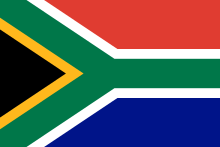 After a relaxing day at the beach, I was ready for a little more action-filled, interesting day. It was so much more to see than the South-African beaches. To be honest, I didn't make a schedule for my trip before I traveled here, so I'm kind of taking this trip on the fly. What to do on a beautiful day like this?
After a relaxing day at the beach, I was ready for a little more action-filled, interesting day. It was so much more to see than the South-African beaches. To be honest, I didn't make a schedule for my trip before I traveled here, so I'm kind of taking this trip on the fly. What to do on a beautiful day like this?As I was walking down the street in my bermuda-shorts and t-shirt, admiring the lovely weather and the beautiful city, I suddenly spotted the South-African flag, waving in the warm, pleasant wind. I was curious about this flag, I had to find out what this flag represented. So I sat down at the closest cafe and did some research. As you can see on the picture, the flag has quite a lot of sections, with its own color. This flag was actually made in 1994 by a man called Frederick G. Brownell, which is a heraldic technician. That means he has a lot of knowledge about weapon brands and coat of arms. Brownell did also make the national flag of Namibia. As we can see in the picture of the South-African flag, it has sections with the blue, red and white color. These colors represent the country's European heritage. Holland and Great Britain were the colonial powers in South-Africa, and as you maybe know, red, blue and white are part of Holland's and Great Britain's flags. The black part of the flag represents Africa, and the horisontal Y represents that these two once will be united.

Ingen kommentarer:
Legg inn en kommentar